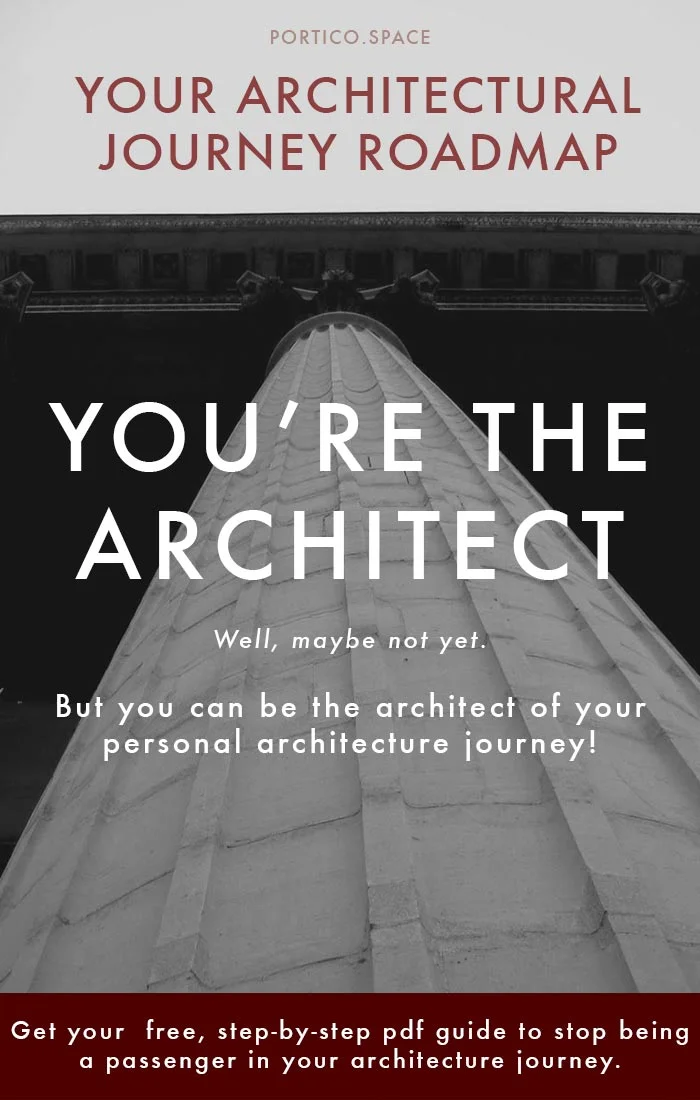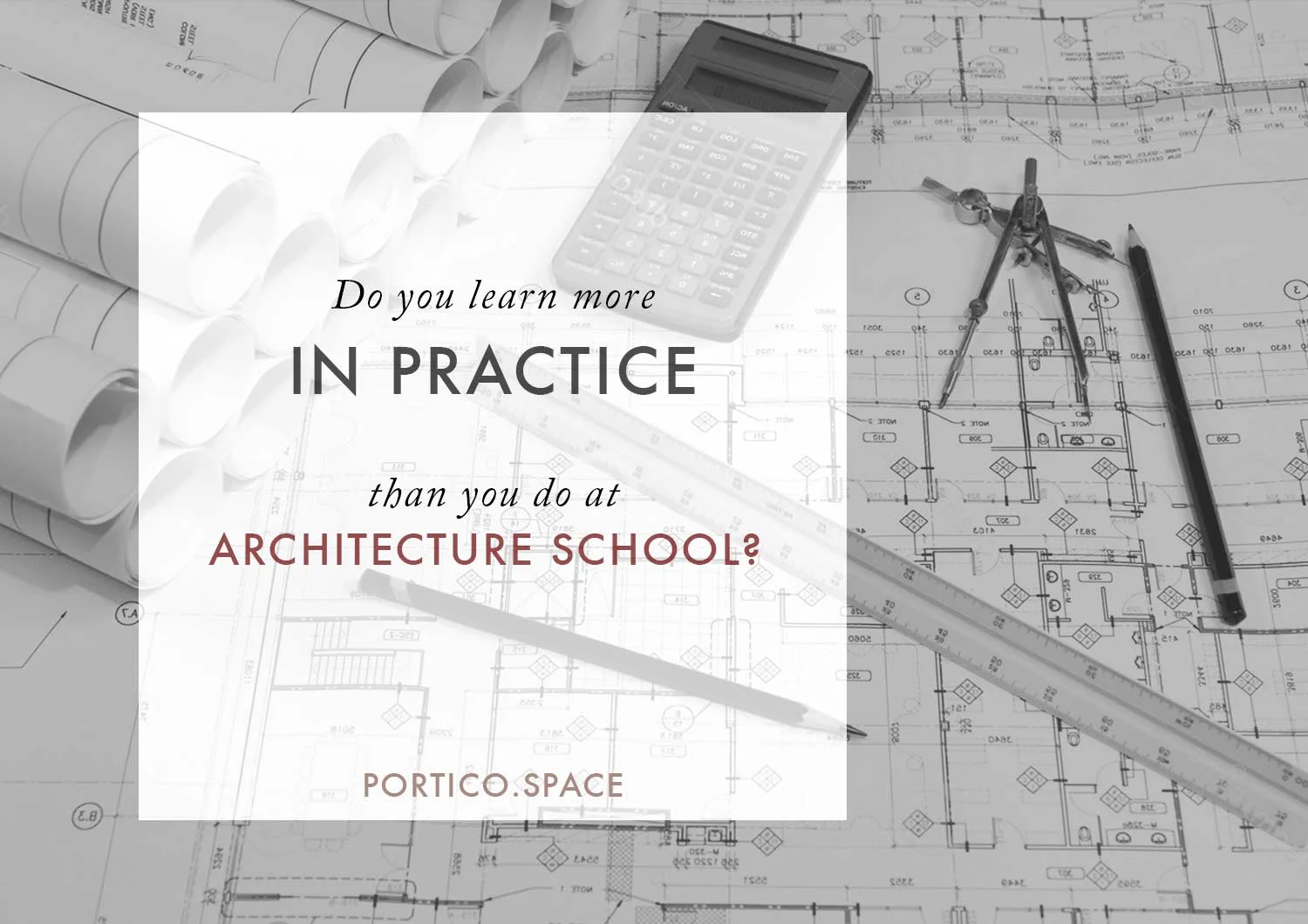IS IT TRUE: Do you really learn more about Architecture in 1 year of practice than you do in 5 years of study?
The ‘gap’ between university and practice is a hot topic of discussion in the architectural community worldwide. A large part of this discussion focuses on scrutinising everything that Architecture School doesn't teach you - but practice does. The phrase I've heard architects and graduates use time and time again when talking to students is that:
"You'll learn more in your first year of practice than you ever did in architecture school."
It's true there are things you won’t learn at Architecture School. But let me ask - did you really plan on studying for 5 years, and then learning nothing more and just going through the motions day in and day out for the next 45 years? Probably not. I certainly plan on - and revel in - learning something new every single day. On the flipside, that doesn't mean I don't value my time at architecture school immensely.
It's interesting to me how much my perspective on learning about architecture, and about what is important, changes over time. After a few years in practice now, I feel like I'm fairly well positioned to assess, from my own experience, not just what but also how I learnt at university, versus the what and how of learning in practice.
And to me - the idea that you'll learn more in 1 year of practice in an architecture firm than you will do in 5 years of study just isn't true. It's a myth.
The myth of learning ABOUT architecture
This post isn't about content - the quantifiable 'stuff' you learn - in either situation, or about how well architecture school 'prepares' you for practice. Instead, I'm going to unpack for you:
why I think it is a myth that you learn more in practice;
the conditions that perpetuate this myth; and
why it's a dangerous way to think - not matter what stage you're at in your journey.
I hope that in doing so, you'll understand that it's just a myth, and doesn't have to be your reality!
Instead of falling prey to the myth, you can choose to be strategic in your education, and take the driving seat in your architectural journey.
That's not to say that the discussion about the relationship between university and practice hasn't had some great outcomes for education: more 'live' projects, better collaborations and group work in studio, and better interface with firms are just some examples of valuable growing initiatives in education. But I think we can achieve these things without relying on dangerous myths to propel the discussion.
So whY IS THIS myth DANGEROUS?
1
It Devalues THE hard work and difficulties faced by students
“Myth: You’ll learn more about architecture in 1 year of practice than in 5 years of university study.”
To me, this myth completely devalues the intense learning, difficulties and revelations that take place in the first few years of studying architecture at university.
I've been there, and I've helped many others work through it - and I know, the struggle is real.
We should be supporting, rather than devaluing, the efforts of everyone at this stage of their journey.
2
It suggests that 'the worst is yet to come.'
But it's more than just devaluation that concerns me. I think the assumption that you learn more in architectural practice than at university has a dangerous underbelly.
It scares people into thinking that 'the worst is yet to come.' Whether or not this is true - we will have have different struggles, joys and responses to different situations - this frame of mind is never healthy, on an individual level or for the profession more widely! It also puts those who have moved into, or past, that 'worse' phase on a pedestal, somehow separating out their experience from that of those in earlier stages.
It invites lazy learning
3
If you're an architecture student right now, one of the most dangerous aspects of the myth that you need to be aware of is that it can invite lazy learning. It's pretty common, and it's a tricky cycle to get out of once you're in it.
How does this happen?
Well, if you're deceived into thinking that you'll have to learn everything again, or differently in practice anyway, you'll probably start wondering why you should put in the effort now. It's easy to get into the habit of being lazy with your learning, either by not actively learning, leaving things to the last minute, or not searching out critical knowledge, when you don't think that knowledge will be as important as what you'll learn in the future.
In the next section of this post, I look at what feeds the myth - and help you to understand the different goal and types of learning that take place at university and in practice. With that knowledge, you'll see why lazy learning is never the answer!
It suggests that architecture is static and complete
- which it's not.
4
Finally, the myth that you learn more in practice than at architecture school suggests that architecture is a static practice, with a finite, measurable amount of knowledge to be learnt. It suggests that once you've learnt it, that's it - you've learnt it.
But it's not like that at all. The practice of architecture is constantly changing in response to technological advancements, changes in environmental conditions, and even just in response to your personal values and skills.
Architecture, and associated careers, are practices of learning. Great architects are constantly honing their crafts.
What FEEDS THE MYTH ?
So if it is a myth, why are so many of us are tricked into thinking that what we learn in practice is not only more than what we learnt at architecture school, but also more valuable?
IN MY EXPERIENCE, THERE ARE 3 ASPECTS THAT CONTINUALLY FEED THE MYTH:
The application of knowledge: the more immediately and obviously you can apply knowledge, the higher you will perceive its value.
Goals & types of learning: University and practice have very different goals, and different timeframes for those goals. As a result, they engage in very different types of learning.
Stage on the learning curve: What stage you are at on the learning curve affects how you view other stages of the learning curve.
You've probably noticed that each of these reasons relates to time. The time between learning and applying knowledge, the timeframes for short or long-term goals, and the time it takes to learn, internalise, and then reflect on your learning. Let's unpack them a little further.
1. The things you learn in practice Are immediately useful
Almost by definition, what you learn and do in practice is directly and immediately applicable to what you need to do practice.
For any company, time is money, and deadlines are pressure points - so you're very unlikely to spend time learning things that just might come in handy next month, let alone doing deeper learning of things that might underpin things you do in 5 years. No. The timeframe is much tighter than that. You learn how to draw something in the morning, and issue the drawing to consultants in the afternoon.
When I spell it out like this, the immediate applicability of learning in practice seems obvious. But let's unpack this a bit further.
How does immediate applicability affect how you value your learning?
In my experience, when you learn something and then can immediately and successfully put what you have learnt into practice, what you have learnt is also immediately validated. You can go home at the end of the day with a clear sense of accomplishment.
This means that, on the surface, the kind of learning you do in practice can seem more valuable than other kinds of learning. How you evaluate the value of what you've learned is skewed by the immediate validation. Your judgement is blurred.
2. university sets you up for longer term opportunities
In contrast, University is often geared towards longer term opportunities. Instead of aiming for immediate application, and attending to a problem at hand, university has different goals, aiming to:
Enable a depth of inquiry which is applicable over a much longer timeframe (your whole life, even);
Establish a breadth of inquiry which sets you up for a variety of outcomes and pathways after study.
Yes, this is different to the workplace. But so it should be! The difference is important, and together, architecture school and practice enable you to form your own pathway in architecture.
The role of architecture school is to lay the foundation. It is where you learn how the learn, and do the hard task of laying the groundwork for all further learning.
3. What you're learning NOW always seems more difficult
than what you learnt then
By the time you get into practice, university is probably largely behind you - the tears, heartache, passion and exaltation of success fade into memory. Everything you learnt during that time has been internalised (hopefully) or, unfortunately forgotten.
On the topic of forgetting things - the number of graduates I have seen who have forgotten key things they learnt at school, usually about structural systems, consenting processes, and the legal aspects of practice always astounds me. Make it your mission to really learn this information when you are encouraged to, rather than having to relearn with less support and more pressure in practice! This contributes to the myth that you learn more in practice than in architecture school, when the reality is that many people just aren't learning effectively in the first place, and so are having to re-learn later.
In contrast, each day in practice brings new challenges, new projects and deadlines - in fact often, no one day's work is exactly like another. On top of the work you're doing, you're also learning how the world of practice works: from workplace dynamics, to client management, to project structures and systems. It's no wonder that what you're learning now seems more difficult than what you learnt then - because you are going through the difficult process of learning. It's just human nature.
BUT REMEMBER THAT WHEN YOU'RE AT UNIVERSITY, IT ALSO FEELS LIKE THE MOST DIFFICULT THING IN THE WORLD.
Concepts feel completely ungraspable, and the amount of information about structural systems and construction methods that you need to learn feels overwhelming. Often, the types of learning you are doing - either in the design studio or in technical lectures - bear little resemblance to the classroom discussions about novels you had at school. With hindsight, high school seemed a breeze.
Let's not devalue this.
THE LEARNING WAVE - CRESTS AND TROUGHS
To me, learning isn't so much a curve, as a series of waves. You go through the crests and troughs of:
unlearning;
relearning;
questioning and consolidating; and finally
mastering.
Sometimes these waves can be moving in different directions, confusing the overall patterns. And every once in while, you'll get everything lined up, and ride the crest of mastery.
Your last year of university is one of those rare moments of mastery - you've internalised everything you struggled with in the first years of university, and you're at the top of your game, ready to move on to the next thing. It can be a shock to get a job and suddenly end up back at the bottom of the wave - have to unlearn and relearn things so you can complete tasks in the specific way your office does them.
Because of where you are on the wave, you're more likely to think that what you're learning right now is the most important and most difficult thing ever. And in doing so, you forget all the learning and failing and testing it took for you to reach that last crest of mastery.
It's Up to you
So do you learn more in 1 year of practice than in architecture school?
In my opinion, no. In practice, you learn differently, you learn different things, and you have more immediate application for your learning. But you're always building on what you learnt in architecture school, and you should always be actively engaging with that learning - no matter what stage you're at.
It's up to you to take charge of your learning.
That's why I put together this step-by-step PDF guide that takes you from outlining your goals, to working on your strengths, and keeps you focused on the value of what and how you are learning at the time. It's totally free - just hit the link above to download and take control.












